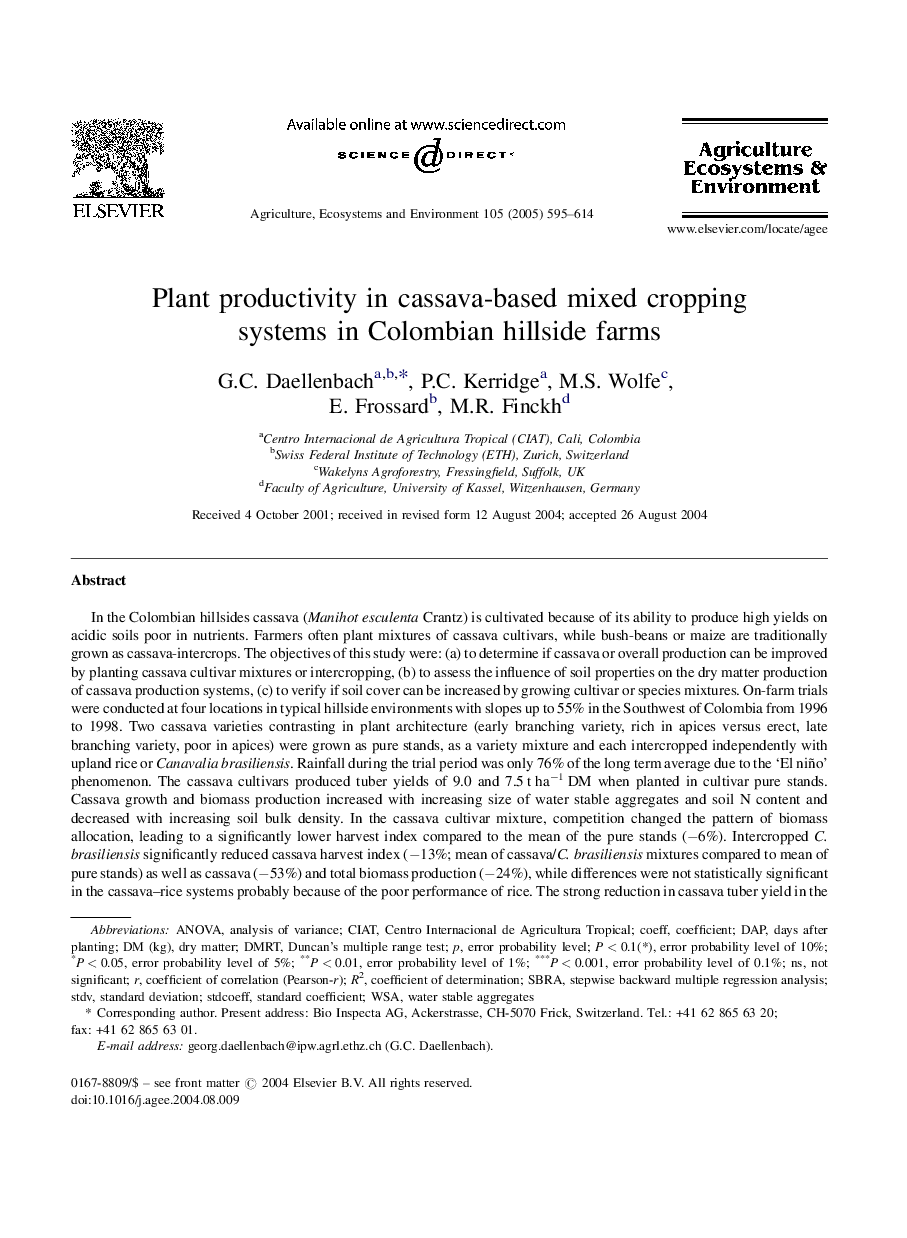| کد مقاله | کد نشریه | سال انتشار | مقاله انگلیسی | نسخه تمام متن |
|---|---|---|---|---|
| 8970916 | 1104007 | 2005 | 20 صفحه PDF | دانلود رایگان |
عنوان انگلیسی مقاله ISI
Plant productivity in cassava-based mixed cropping systems in Colombian hillside farms
دانلود مقاله + سفارش ترجمه
دانلود مقاله ISI انگلیسی
رایگان برای ایرانیان
کلمات کلیدی
DAPCIATWSASoil structure stabilityDMRTDuncan's Multiple Range Test - آزمایش چندتایی دانکنstandard deviation - انحراف معیارUpland rice - برنج برنجanalysis of variance - تحلیل واریانسANOVA - تحلیل واریانس Analysis of variancebulk density - تراکم فلهWater stable aggregates - دانه های پایدار آبdays after planting - روز بعد از کاشتcoefficient - ضریبcoefficient of determination - ضریب تعیینdry matter - ماده خشکCassava - مانیوک، کاساوCultivar mixture - مخلوط ارگانیکnot significant - مهم نیستSoil cover - پوشش خاکIntercropping - کشت مخلوط
موضوعات مرتبط
علوم زیستی و بیوفناوری
علوم کشاورزی و بیولوژیک
علوم زراعت و اصلاح نباتات
پیش نمایش صفحه اول مقاله

چکیده انگلیسی
In the Colombian hillsides cassava (Manihot esculenta Crantz) is cultivated because of its ability to produce high yields on acidic soils poor in nutrients. Farmers often plant mixtures of cassava cultivars, while bush-beans or maize are traditionally grown as cassava-intercrops. The objectives of this study were: (a) to determine if cassava or overall production can be improved by planting cassava cultivar mixtures or intercropping, (b) to assess the influence of soil properties on the dry matter production of cassava production systems, (c) to verify if soil cover can be increased by growing cultivar or species mixtures. On-farm trials were conducted at four locations in typical hillside environments with slopes up to 55% in the Southwest of Colombia from 1996 to 1998. Two cassava varieties contrasting in plant architecture (early branching variety, rich in apices versus erect, late branching variety, poor in apices) were grown as pure stands, as a variety mixture and each intercropped independently with upland rice or Canavalia brasiliensis. Rainfall during the trial period was only 76% of the long term average due to the 'El niño' phenomenon. The cassava cultivars produced tuber yields of 9.0 and 7.5 t haâ1 DM when planted in cultivar pure stands. Cassava growth and biomass production increased with increasing size of water stable aggregates and soil N content and decreased with increasing soil bulk density. In the cassava cultivar mixture, competition changed the pattern of biomass allocation, leading to a significantly lower harvest index compared to the mean of the pure stands (â6%). Intercropped C. brasiliensis significantly reduced cassava harvest index (â13%; mean of cassava/C. brasiliensis mixtures compared to mean of pure stands) as well as cassava (â53%) and total biomass production (â24%), while differences were not statistically significant in the cassava-rice systems probably because of the poor performance of rice. The strong reduction in cassava tuber yield in the cassava/C. brasiliensis systems was due to competition for water between cassava and the intercrop, aggravated by the lack of rain. The percentage of soil cover was slightly higher in all mixed cropping systems compared to the pure stands. In contrast to the mixture concept which seeks to increase productivity and soil cover compared to monocropping, the mixed cropping systems used in the studies in Rio Cabuyal reduced cassava tuber yield and total biomass production of the cropping systems compared to the cassava cultivar monocrops. When total soil cover was improved compared to the cassava cultivar pure stands it was paralleled by reductions in terms of cassava tuber yield.
ناشر
Database: Elsevier - ScienceDirect (ساینس دایرکت)
Journal: Agriculture, Ecosystems & Environment - Volume 105, Issue 4, 5 March 2005, Pages 595-614
Journal: Agriculture, Ecosystems & Environment - Volume 105, Issue 4, 5 March 2005, Pages 595-614
نویسندگان
G.C. Daellenbach, P.C. Kerridge, M.S. Wolfe, E. Frossard, M.R. Finckh,